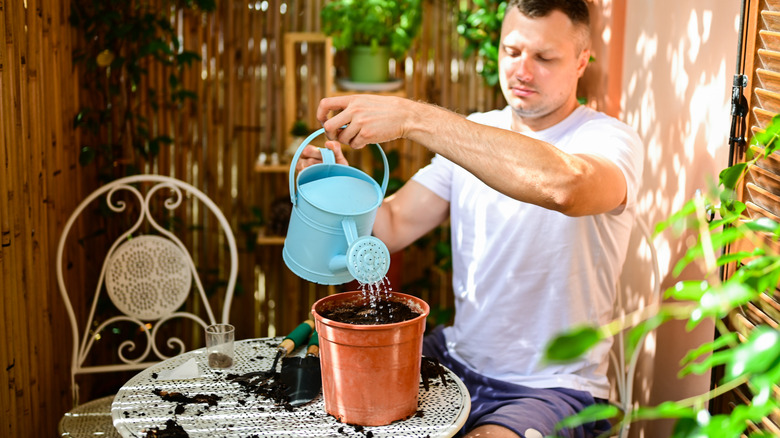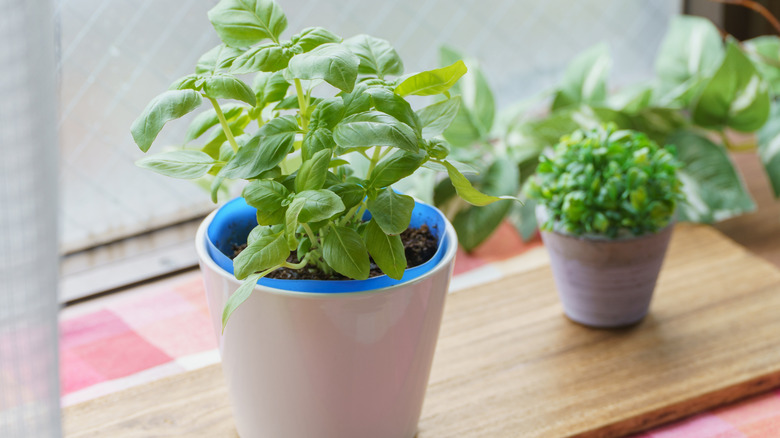The Small Tree Variety That Grows Exceptionally Well In A Container
We may receive a commission on purchases made from links.
Limited yard space is no excuse to deny yourself the benefits of greenery. Armed with a wood or clay container, along with a few tweaks on the site's conditions, you can give your home a shot of ornamental green and your cooking an aromatic boost. For that, simply pot up the container with the sweet bay (Laurus nobilis), a.k.a. bay leaf, an evergreen plant whose leathery leaves, whether fresh or dried, are used to flavor soups and stews. This hardy perennial herb will offer year-round harvests, is evergreen, and offers visual interest right through winter. Perfumed waves of yellowish-green blooms in spring are a bonus.
So, what makes sweet bay an exceptional contender for container gardening? For a start, this Mediterranean herb grows slowly, and when it does, it stays about 8 feet tall and wide, which is easily managed in containers. Still, if you find its growth unwieldy, you can prune the plant to the desired size. In fact, it responds so well to pruning that you can sculpt sweet bay into beautiful shapes for an eclectic touch. As for the hardiness range, sweet bay can be maintained year-round in frost-free areas of zones 8b through 10. Outside of that range, it can be grown as a houseplant or just overwintered inside.
Planting sweet bay in containers
Although sweet bay can be started with seeds or cuttings, either the success rate is abysmal or the plant takes a long time to mature, making the process tedious. For this reason, it's best to purchase established plants from the local nursery or try out online retailers, like Amazon. In the first season, you can maintain the herb in the shipped container, assuming it has a drainage hole, or move it into a 5-gallon pot.
Outdoors, sweet bay requires over six hours of direct sun exposure. However, in particularly hot climates, move the plant to a shaded spot or drape it in a shade cloth to protect from the afternoon heat. Indoors, keep the vessel in a sunny window, preferably south-facing, or supplement with grow lights and LED lamps. Here are some of the best grow lights for indoor plants, according to reviews, that you may explore. Note that when consumed in excessive quantities, sweet bay can be toxic for pets. So, locate their containers accordingly. As for potting substrate, choose a well-draining, compost-based mix or a commercial organic potting mix, like the Espoma All Natural Potting Mix. If it stays damp for too long, add grit to improve drainage, or the roots may rot.
Caring for sweet bay in containers
Sweet bay plants are easily maintained in containers. When the topsoil feels dry down to its first inch, give the roots a nice soak. During the summers or in especially brightly-lit conditions, this may amount to watering every other week to compensate for the additional water loss. As sweet bay herbs are grown for their lush foliage, you must ensure their nutrient requirements are met. Throughout the growing season, feed them a balanced fertilizer, such as Bonide Houseplant Liquid Plant Food, every fortnight.
If you can maintain their cultural conditions throughout the year, continue to water and fertilize the plant as is. But if you're overwintering them in a cold room where temperatures stay under 60 degrees Fahrenheit, taper off on watering and fertilization because the plants will have gone dormant. Also, monitor their growth for scales and other common pests that can wreak havoc on houseplants during winter.
When spring rolls in, prune sweet bay to stimulate new growth and for size containment. Repeat this practice every year while repotting the plant in a container that's one size bigger than its current girth. This way, you can refresh the soil, too. However, if you don't want the plant outgrowing its container, prune the girdling roots every other year and pot it in fresh soil.


